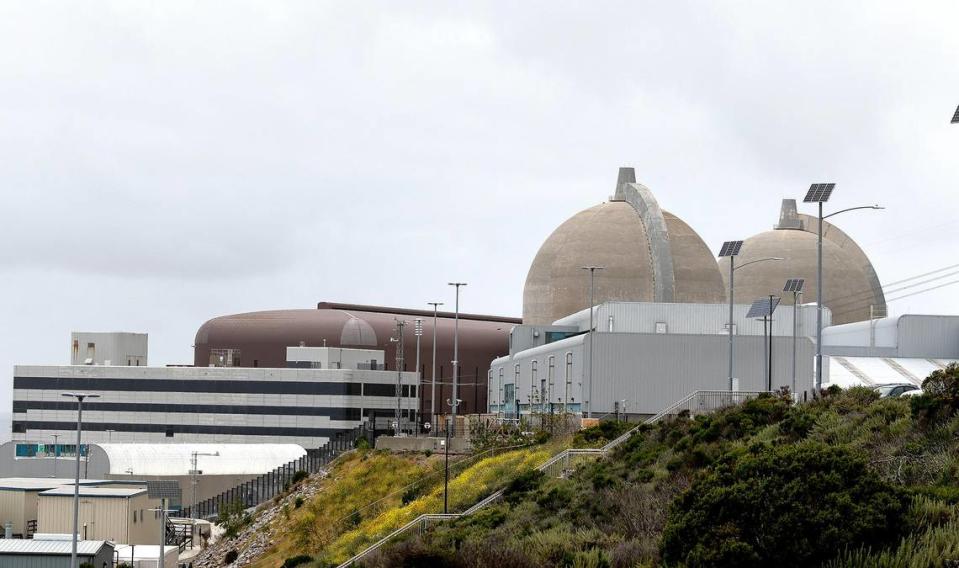Diablo Canyon nuclear power plant gets key approval to continue operating. Here’s why
In an important regulatory move on Thursday, the California Public Utilities Commission authorized PG&E to continue operating Diablo Canyon nuclear power plant near Avila Beach.
The vote came a little more than a month after PG&E filed a license renewal application with the U.S. Nuclear Regulatory Commission to keep Diablo Canyon’s two reactors open another 20 years past their originally scheduled closure dates in 2024 and 2025.
The commission, the agency that regulates privately owned public utilities in California, found in its Thursday decision that not enough clean energy had been procured to replace the 2,200-megawatt nuclear power plant and that it couldn’t determine with the information it had at the time whether the costs of extended operation are “too high to justify.”
Therefore, the commission was required by Senate Bill 846, signed by Gov. Gavin Newsom in September 2022, to set the plant’s new retirement dates as Oct. 31 in 2029 and 2030 for the two reactors.
The five-person commission voted 3-0 in favor of the decision, with Darcie Houk abstaining and Genevieve Shiroma absent.
“We are implementing a highly detailed and highly complex statute,” commissioner Karen Douglas said during the Thursday meeting.
Douglas stressed that the commission’s vote should not constitute a reliance on Diablo Canyon, but instead should ensure the 2,200-megawatt power plant remains a tool to bridge the gap between the clean energy supply constraints the state faces now and the future supply expected.
“ In line with the state’s direction, we remain focused on providing reliable, low-cost, emission-free energy to Californians, while safely operating the state’s largest clean energy producer,” PG&E spokesperson Suzanne Hosn wrote in an emailed statement to The Tribune.

Cost of Diablo Canyon’s extended operations to be distributed among all California ratepayers
The commission noted in its decision that keeping the Diablo Canyon nuclear power plant operating even five years past its original closure dates may cost “billions of ratepayer dollars.”
The Environmental Working Group, a nonprofit organization, released a report in July estimating that keeping the plant open could cost PG&E’s ratepayers $20 billion to $45 billion.
As a result, the commission voted to spread that expense across all California ratepayers, because it determined the plant is filling a gap and helping to maintain the state energy grid reliability.
In alignment with SB 846, the commission will include extended Diablo Canyon operating costs in the energy bills sent out by all electric energy providers regulated by the agency, not just PG&E.
It’s unclear what that impact might look like on people’s energy bills.
“One hundred percent of market revenues will be used to offset costs of continued plant operations,” Hosn wrote in her emailed statement. “As such, customers could see little-to-no change or even a credit on their bills due to extended operations at (Diablo Canyon).”
Hosn added that PG&E “will be filing cost recovery applications at the CPUC annually that will address customer impacts going forward.”
Commission unable to determine if extended operation costs are ‘too high to justify’
Under SB 846, the commission was required to determine whether extended operations at Diablo Canyon are “too high to justify” or “not cost-effective or imprudent.”
However, at the time of its decision, the commission said it didn’t have enough information to come to such a conclusion.
“At the time of this decision there are no recommendations from the (Diablo Canyon Independent Safety Commission) for seismic safety upgrades or deferred maintenance activities associated with extended Diablo Canyon operations, nor does the commission have before it any (U.S. Nuclear Regulatory Commission) license renewal commitments or conditions,” the commission wrote in its decision. “Absent any actual recommendations and conditions from the DCISC and NRC, it is not possible for the Commission to assess whether associated, unknown costs render the extension of Diablo Canyon operations too high to justify.”
The commission added that it expects the DCISC’s recommendations concerning seismic safety and deferred maintenance possibly by the body’s next public meeting on Feb. 21 and 22.
The NRC’s “license renewal commitments or conditions” may also come as the federal agency reviews PG&E’s application to renew Diablo Canyon’s license.

As part of its decision, the commission required PG&E to provide “more information regarding the historical operating costs of the plant as well as cost forecasts for continued operations.”
Additionally, the commission found that California’s electric system “is much closer to a supply and demand balance than is comfortable for reliability purposes.”
Although anti-nuclear advocates have long maintained that the state has enough clean energy sources coming online to replace Diablo Canyon in the coming years to maintain system reliability, the commission’s Thursday decision was limited to the sources online by the end of this year.
“All of the reliability studies in this proceeding assume continued procurement during the 2024-2028 time period,” the commission’s Thursday decision said, adding that public utilities are required to bring online at least 2,500 megawatts of clean energy resources by June 2025 “as an explicit showing of replacement capacity for Diablo Canyon.”
However, the agency was required by SB 846 to only consider whether keeping Diablo Canyon open was prudent based on grid reliability issues concerning renewable and zero-carbon resources that “have already been constructed and interconnected” by the end of 2023.

